|
(11) | EP 1 353 923 B1 |
| (12) | EUROPEAN PATENT SPECIFICATION |
|
|
| (54) |
IMPROVED PROCESS FOR CARBAPENEM SYNTHESIS VERBESSERTER PROZESS ZUR HERSTELLUNG VON CARBAPENEMEN PROCEDE AMELIORE POUR LA SYNTHESE DE CARBAPENEMS |
|
|
|||||||||||||||||||||||||||||||||||
| Note: Within nine months from the publication of the mention of the grant of the European patent, any person may give notice to the European Patent Office of opposition to the European patent granted. Notice of opposition shall be filed in a written reasoned statement. It shall not be deemed to have been filed until the opposition fee has been paid. (Art. 99(1) European Patent Convention). |
BACKGROUND OF THE INVENTION
[0001] The present invention relates to a process for synthesizing carbapenem intermediates and compounds.
[0002] The carbapenems are among the most broadly effective antibiotics making them useful in the treatment of a wide range of bacterial infections. The continuing emergence of bacteria exhibiting resistance to existing therapeutic agents has made development of new carbapenems an important part of our strategy in addressing this problem.
[0003] The process developed for the manufacture of the carbapenem antibiotics disclosed herein is known to make use of a palladium-catalyzed hydrogenolysis of a p-nitrobenzyl ester. The reaction is conducted at pH 6.5 to 8.5 to minimize degradation of the product. Filtration in this pH range to remove the solid catalyst following the reaction results in a solution containing unacceptably high levels of palladium. This problem has been solved in the past by adjusting the pH to below 6 prior to filtration. This pH adjustment, however, results in degradation of the product and introduces salts, which must be removed prior to isolation of the product.
[0004] This invention relates to a process that utilizes prereduced catalysts to achieve a significantly lower level of solubilized metal derived from the catalyst following the reaction.
SUMMARY OF THE INVENTION
[0005] A process for synthesizing a compound represented by formula I:
or a pharmaceutically acceptable salt thereof, is disclosed, wherein R1 and R2 independently are H, C1-10 alkyl, aryl or heteroaryl, substituted or unsubstituted, comprising deprotecting a compound of formula II:
by hydrogenolysis in the presence of a prereduced metal catalyst, purifying and isolating the compound of formula I, wherein P is a carboxyl protecting group, P* is H, H2+, or a protecting group which can be removed by hydrogenolysis such as carbobenzyloxy (CBZ), or p-nitrobenzyl carbamoyl (PNZ), and R1 and R2 are as described above.
[0006] These and other aspects of the invention can be realized upon complete review of the application.
DETAILED DESCRIPTION OF THE INVENTION
[0007] The invention is described herein in detail using the terms defined below unless otherwise specified.
[0008] The term "alkyl" refers to a monovalent alkane (hydrocarbon) derived radical containing from 1 to 15 carbon atoms unless otherwise defined. It may be straight or branched, and when of sufficient size, e.g., C3-15 may be cyclic. Preferred straight or branched alkyl groups include methyl, ethyl, propyl, isopropyl, butyl and t-butyl. Preferred cycloalkyl groups include cyclopropyl, cyclopentyl and cyclohexyl.
[0009] Alkyl also includes an alkyl group substituted with a cycloalkyl group such as cyclopropylmethyl.
[0010] Alkyl also includes a straight or branched alkyl group which contains or is interrupted by a cycloalkylene portion. Examples include the following:
wherein: x' and y' = from 0-10; and w and z = from 0-9.
[0011] When substituted alkyl is present, this refers to a straight, branched or cyclic alkyl group as defined above, substituted with 1-3 groups as defined with respect to each variable.
[0012] Aryl refers to aromatic rings e.g., phenyl, substituted phenyl and like groups as well as rings which are fused, e.g., naphthyl and the like. Aryl thus contains at least one ring having at least 6 atoms, with up to two such rings being present, containing up to 10 atoms therein, with alternating (resonating) double bonds between adjacent carbon atoms. The preferred aryl groups are phenyl and naphthyl. Aryl groups may likewise be substituted as defined below. Preferred substituted aryls include phenyl and naphthyl substituted with one to three groups.
[0013] The term "heteroaryl" refers to a monocyclic aromatic hydrocarbon group having 5 to 6 ring atoms, or a bicyclic aromatic group having 8 to 10 atoms, containing at least one heteroatom, O, S or N, in which a carbon or nitrogen atom is the point of attachment, and in which one additional carbon atom is optionally replaced by a heteroatom selected from O or S, and in which from 1 to 3 additional carbon atoms are optionally replaced by nitrogen heteroatoms. The heteroaryl group is optionally substituted with up to three groups.
[0014] Heteroaryl includes aromatic and partially aromatic groups which contain one or more heteroatoms. Examples of this type are thiophene, purine, imidazopyridine, pyridine, oxazole, thiazole, oxazine, pyrazole, tetrazole, imidazole, pyridine, pyrimidine, pyrazine and triazine. Examples of partially aromatic groups are tetrahydroimidazo[4,5-c]pyridine, phthalidyl and saccharinyl, as defined below.
[0015] Substituted alkyl, aryl and heteroaryl, and the substituted portions of aralkyl, aralkoxy, heteroaralkyl, heteroaralkoxy and like groups are substituted with from 1-3 groups selected from the group consisting of: halo, hydroxy, cyano, acyl, acylamino, aralkoxy, alkylsulfonyl, arylsulfonyl, alkylsulfonylamino, arylsulfonylamino, alkylaminocarbonyl, alkyl, alkoxy, aryl, aryloxy, aralkoxy, amino, alkylamino, dialkylamino, carboxy, trifluoromethyl and sulfonylamino.
[0017] A preferred process for synthesizing a compound represented by formula Ia:
or a pharmaceutically acceptable salt thereof, is disclosed, comprising deprotecting a compound of formula IIa:
by hydrogenolysis in the presence of a prereduced metal catalyst, purifying and isolating the compound of formula Ia, wherein P is a carboxyl protecting group, P* is H, H2+, or a protecting group which can be removed by hydrogenolysis such as carbobenzyloxy (CBZ), or p-nitrobenzyl carbamoyl (PNZ), and X+ is a charge-balancing group. By using a prereduced catalyst, the levels of solubilized metal derived from the catalyst are significantly lower compared with the use of an unreduced catalyst. The level of solubilized metal is negligible in the sense that it is possible to isolate the compound of formula I containing pharmaceutically acceptable levels of the metal derived from the catalyst, said levels would expose a patient to no more than about 50 micrograms per day of the metal, preferably no more than 25 micrograms per day. Examples of the metal catalysts are those described herein.
[0018] In another aspect of the invention a process for synthesizing a compound represented by formula I:
or a pharmaceutically acceptable salt thereof, containing pharmaceutically acceptable levels of a metal derived from a metal catalyst is disclosed, wherein R1 and R2 independently are H, C1-10 alkyl, aryl or heteroaryl, said alkyl, aryl or heteroaryl being substituted or unsubstituted, comprising deprotecting a compound of formula II:
by hydrogenolysis in the presence of a prereduced metal catalyst, purifying and isolating the compound of formula I, wherein P is a carboxyl protecting group, P* is H, H2+, or a protecting group which can be removed by hydrogenolysis, and R1 and R2 are as described above. A preferred aspect of this process is realized when it is conducted with a compound of formula IIa to produce a compound of formula Ia.
[0019] The compounds of formula I and Ia' can be obtained as shown below in Flow Sheets A-1 and A-2, respectively.
[0021] Compounds 1, 1a, 2 and 2a can be obtained in accordance with techniques such as those disclosed in U.S. Patent Nos. 5,034,384, granted on July 23, 1991; 5,952,323, granted on September 14, 1999; 4,994,568 granted on February 19, 1991; 4,269,772 granted on May 26,1981; 4,350,631 granted on September 21, 1982; 4,383,946 granted on May 17,1983; 4,414,155 granted on November 8, 1983; U.S. Patent No. 6,063,931, granted May 16, 2000; EP-A-562855; Tetrahedron Lett. 21, 2783 (1980); J. Am. Chem. Soc. 102, 6161 (1980); J. Am. Chem. Soc. 108, 4675 (1986) and 5,478,820 granted on December 26,1995. Compounds of formula I and Ia and derivatives thereof and processes thereof are disclosed in U.S. Patent Nos. 5,872,250, granted February 16, 1999 and 6,180,783, granted January 30, 2001.
[0022] The compounds of formula II or IIa' or salts thereof are produced by reacting the enol phosphate 1 or 1a and thiol 2 or 2a in the presence of a base. This reaction is typically conducted at reduced temperature, e.g., about -30°C to about -70°C, preferably about -40°C to about -60°C. Bases which are suitable for the above reaction include organic as well as inorganic bases. Preferred bases for use herein are secondary and tertiary amines such as diisopropylamine (DIPA), dicyclohexylamine (DCHA), 2,2,6,6-tetramethylpiperidine (TMP), guanidines such as 1,1,3,3-tetramethylguanidine (TMG), N,N,N',N'N"-tetraethylcyclohexylguanidine (TECHG), N,N',N",N"-dicyclohexyldiethylguanidine (DCDBG) and amidines such as 1,8-diazabicyclo[4.3.0]undec-7-ene (DBU) and 1,5-diazabicyclo [4.3.0]non-5-ene (DBN). Most preferable bases are the guanidine bases and even more preferred is TMG.
[0023] An antioxidant is optionally added. Preferred antioxidants are PR3, wherein R3 belongs to the group consisting of C1-8 alkyl, aryl or heteroaryl, or aromatic phenols such as BHT (butylated hydroxy toluene) and BHA (butylated hydroxy anisole). Most preferred antioxidant is PBu3.
[0024] The reaction can be conducted in a polar organic solvent, e.g., N-ethylpyrrolidinone (NEP), N-methylpyrrolidinone, N,N-dimethylformamide (DMF), N,N-dimethylacetamide (DMA), acetonitrile, propionitrile, or a mixture thereof and the like. The preferred solvent is N-ethylpyrrolidinone (NBP).
[0025] After coupling, the carbapenem can be stabilized by combining the carbapenem with a carbon dioxide source. Stabilization can be conducted according to the teachings in U.S. Patent No. 6,180,783, granted January 30, 2001.
[0026] The carbapenem is subjected to deprotection, thus removing the 3-carboxyl protecting group yielding I or Ia'.
[0027] In the claimed invention, hydrogenolysis is conducted in the presence of a prereduced metal catalyst. The preferred reaction involves H2 gas with a prereduced palladium (Pd on carbon) catalyst. The reaction can be conducted under hydrogen over a broad pressure range, preferably above 2,76 bar (40 psi). A base such as sodium hydroxide or sodium bicarbonate can be added during the reaction to control pH. Sufficient sodium bicarbonate can be present at the start of the reaction to control the pH. Preferably, the reaction is conducted in the presence of a source of carbon dioxide such as sodium bicarbonate to give the stabilized form 3 or 3a where X+ is a charge-balancing group.
[0028] Suitable catalysts are those which contain a metal known to be useful for catalytic hydrogenation such as palladium (Pd), platinum (Pt), and rhodium (Rh), preferably Pd. The metal catalyst can be a salt or metal powder or supported on a wide range of solid supports known to be useful in catalytic hydrogenation reactions including alumina, silica, calcium carbonate, barium carbonate, barium sulfate, strontium carbonate, polymers, or carbon, preferably activated carbon. The catalyst is used in an amount that is at least 5 mol% relative to the carbapenem substrate. A prereduced catalyst is formed by chemical treatment with a reducing agent prior to addition of the substrate. Suitable reducing agents include those known to be useful for the reduction of metal catalysts such as formate, borohydride, and hydrogen, preferably hydrogen. The reduction can be performed in manufacture of the catalyst or just prior to use. The pH can be controlled during reduction by addition of a base. Preferred bases are sodium hydroxide or sodium bicarbonate.
[0029] Carbon dioxide sources, as used herein, refer to carbon dioxide gas as well as compounds which can produce carbon dioxide in solution. Representative examples include carbonates and bicarbonates, such as sodium carbonate, sodium bicarbonate, potassium carbonate and potassium bicarbonate. Preferably, the carbon dioxide source is sodium bicarbonate. The sodium bicarbonate can be purchased or obtained by mixing sodium hydroxide and carbon dioxide at a pH above about 6.5. The carbon dioxide source can alternatively be included in the reaction medium prior to or added during the deprotection reaction.
[0030] Examples of suitable 3-carboxyl protecting groups are those which can be removed by hydrogenolysis. Examples of such protecting groups are: benzhydryl, o-nitrobenzyl, p-nitrobenzyl, 2-naphthylmethyl, and benzyl. A preferred carboxyl protecting group is p-nitrobenzyl (PNB). Many other suitable protecting groups are known in the art. See, e.g., T.W. Greene, Protective Groups in Orizanic Synthesis, John Wiley & Sons, Inc., 1981 (Chapters 2 and 5).
[0031] Numerous salt-forming ions are recited in Berge, S. M., et al. J. Pharm. Sci. 66(1): 1-16 (1977), the teachings of which are incorporated herein by reference. The charge balancing group X+ maintains overall charge neutrality. Preferably X+ represents a pharmaceutically acceptable salt-forming cation. Preferred salt-forming cations are selected from the group consisting of: sodium, potassium, calcium and magnesium. More preferably the salt-forming cation is a member selected from the group consisting of: Na+, Ca+2 and K+.
[0032] The salt-forming cations mentioned above provide electronic balance and overall charge neutrality. From zero to three positively charged counterions may be present depending upon the number of charged moieties on the carbapenem. The number of negatively charge groups is largely a function of pH, since these groups become protonated as the pH is lowered. For every positively charged functional group on the molecule, a negatively charged counterion is present to provide overall charge neutrality. Different counterions may also be included in the overall reaction composition. Hence, for example, calcium and sodium could be included together in the reaction to provide overall charge neutrality. The counterions can thus be varied within wide limits. Generally, the counterion or counterions are pharmaceutically acceptable cationic species.
[0033] The compounds formed in the present invention have asymmetric centers and occur as racemates, racemic mixtures, and as individual diastereomers. The processes of synthesizing all such isomers, including optical isomers, are included in the present invention.
[0034] Purification and isolation of compounds of formula I and Ia can be achieved via a combination of several operations: extractions using solvents such as dichloromethane to remove residual organic solvents, chromatography using hydrophobic resin chromatography (eluting with 0.05 M sodium bicarbonate at about 5°C), nanofiltration for concentration of the process stream followed by crystallization of the pure drug (See U.S.S.N. 09/093813, filed 6/9/1998).
[0035] Alternatively, the column chromatography and nanofiltration operations can be eliminated when the extraction is carried out with an appropriate alcohol. A preferred extraction is carried out with the appropriate alcohol in the presence of an ion-pairing reagent. The process described below allows a direct crystallization of carbapenem compounds after this type of extraction.
[0036] The extractions can be conducted by methods generally known in the art. A preferred extraction process is discussed in U.S.S.N 09/487,044 filed 1/19/2000. An example of the extraction involves extracting a solution containing a compound of formula I, Ia, 3, or 3a, or a pharmaceutically acceptable salt thereof, wherein each X+ is a charge-balancing group and is present or absent as necessary to provide overall charge neutrality, with an alcohol, crystallizing and collecting a compound of formula I or Ia' from the resultant aqueous phase. It is preferable that the extraction is conducted in the presence of an ion-pairing reagent and that pH of the aqueous phase is maintained between neutral and mildly basic pH (pH 7 to 9) according to the teachings of WO 9745430. It is also preferable that the extraction is performed while I or Ia is stabilized in the form, 3 or 3a. After extraction, the stabilized form 3 or 3a is readily converted to a salt form of I or Ia under neutral to mildly acidic conditions (pH 7 to 5). The pH is adjusted to produce the appropriate salt form of I or Ia for isolation by crystallization. Alternatively, there can be multiple extractions with, for example the example solvents being isoamyl alcohol (IAA) /DPP solution in the first extraction, and IAA in a second extraction.
[0037] It is preferable to use equipment that is capable of multi-stage extraction such as mixer-settler cascade, spray tower, baffle tower, packed tower, perforated plate tower, mechanically agitated extractor, pulsed extractor, reciprocating plate extractor, or centrifugal extractor for optimal performance. Most preferable is the use of a multi-stage centrifugal extractor. The preferred equipment is dependent on scale; CINC (Costner Industries Nevada Corporation) liquid-liquid centrifugal separators are preferred for laboratory scale operation; whereas, a Podbielniak® centrifugal extractor is preferred for large scale operation.
[0038] Use of these multi-stage centrifugal extractor provides unexpected benefits. For example, the ion pairing reaction of TMG with diphenyl phosphate (DPP) is used to reduce the TMG level in the process stream prior to the isolation of the compound of formula I, Ia, 3 or 3a. In addition to this purification, the residual reaction solvent, N-ethyl pyrrolidinone (NEP) must be removed from the process stream, and the process stream must be concentrated four fold to allow successful crystallization of the compound of formula I, Ia, 3 or 3a. All three of these processing requirements are accomplished simultaneously via a rapid, multi-stage, countercurrent centrifugal extraction, which minimizes the soluble product degradation during processing.
[0039] The alcohol useful for the present invention includes but is not limited to iso-amyl alcohol, tert-amyl alcohol, 1-butanol, 2-butanol, 1-octanol, 1-hexanol, 1-heptanol, cyclohexanol, 1-pentanol, cyclopentanol, 2-pentanol, 2-methyl-1-pentanol, 2-ethyl-1-butanol, 4-methyl-2-pentanol, 2,6-dimethyl-4-heptanol, 2-methylcyclohexanol, preferably 1-butanol or iso-amyl alcohol.
[0040] Preferred ion-pairing reagents for use in the present invention are C6-24 carboxylic acids, phosphoric acids, phosphinic acids, sulfonic acids and the like and their salts. Most preferred ion-pairing reagents are the sodium salts of diphenylphosphoric acid, stearic acid or dodecylbenzenesulfonic acid.
EXAMPLE
[0041]
A hydrogenator is charged with 63 g of 10% Pd on carbon catalyst (dry weight) in 1.8 L of water. The vessel is placed under hydrogen then vented and placed under nitrogen. Sodium hydroxide (68 g, 50%) is charged adjusting the pH to about 7.5 with carbon dioxide.
The enol phosphate (170 g) and the thiol (86 g) are dissolved in 1.3 L of N-ethylpyrrolidinone (NEP). The mixture is cooled to below -40°C and 1,1,3,3-tetramethylguanidine (109 g) is added. After 3 hours, the reaction mixture is quenched into the hydrogenator at below 15°C adjusting the pH to about 8 with carbon dioxide. The vessel is placed under hydrogen. When the reaction is complete, the hydrogen is vented and the reaction mixture is treated with activated carbon and filtered. The filtrate is extracted with iso-amyl alcohol containing diphenylphosphoric acid (240 g) and 50% NaOH (44 g). The resulting aqueous solution is further extracted with iso-amyl alcohol to give an aqueous solution containing at least 90 mg/mL of the product. Both extractions are performed using two CINC centrifugal separators set in series for countercurrent extraction. The pH is adjusted to 5.5 with acetic acid. The product is crystallized by adding equal volumes of methanol and 1-propanol at below -5°C and isolated by filtration. The solid is washed with a mixture of 2-propanol and water (85:15 v/v) then dried to yield a compound of formula Ia'.
1. A process for synthesizing a compound represented by formula I:

or a pharmaceutically acceptable salt thereof, wherein R1 and R2 independently are H, C1-10 alkyl, aryl or heteroaryl, said alkyl, aryl or heteroaryl being substituted or unsubstituted, comprising deprotecting a compound of formula II:

by hydrogenolysis in the presence of a prereduced metal catalyst and base to give the compound of formula I, followed by purifying and isolating the compound of formula I, wherein P is a carboxyl protecting group, P* is H, H2+, or a protecting group which can be removed by hydrogenolysis, and R1 and R2 are as described above.
or a pharmaceutically acceptable salt thereof, wherein R1 and R2 independently are H, C1-10 alkyl, aryl or heteroaryl, said alkyl, aryl or heteroaryl being substituted or unsubstituted, comprising deprotecting a compound of formula II:
by hydrogenolysis in the presence of a prereduced metal catalyst and base to give the compound of formula I, followed by purifying and isolating the compound of formula I, wherein P is a carboxyl protecting group, P* is H, H2+, or a protecting group which can be removed by hydrogenolysis, and R1 and R2 are as described above.
2. A process according to claim 1 wherein the protecting group is carbobenzyloxy or p-nitrobenzyl
carbamoyl (PNZ).
3. A process according to claim 1 wherein one of R1 or R2 is hydrogen and the other is an aryl substituted with CO2H.
4. A process according to claim 1 wherein the prereduced metal catalyst is a palladium,
platinum or rhodium catalyst.
5. A process according to claim 4 wherein the metal catalyst is a salt or metal powder
or supported on solid supports selected from the group consisting of alumina, silica,
calcium carbonate, barium carbonate, barium sulfate, strontium carbonate, polymers,
or carbon.
6. A process according to claim 5 wherein the metal catalyst is prereduced palladium
on carbon.
7. A process according to claim 1 wherein the base is bicarbonate or hydroxide and carbon
dioxide mixed to make bicarbonate.
8. A process according to claim 6 further comprising purifying the compound using hydrophobic
resin chromatography.
9. A process according to claim 8 further comprising concentrating the compound in solution
using a nanofiltration membrane.
10. A process according to claim 9 further comprising crystallizing the compound.
11. A process according to claim 1 wherein the purification step consists of treatment
with activated carbon.
12. A process according to claim 6 further comprising extracting a solution containing
a compound of formula I or 3:

or a pharmaceutically acceptable salt thereof, wherein each X+ is a charge-balancing group, and R1 and R2 are as described above with a C4-10 alcohol, purifying and isolating the compound of formula I from the resulting aqueous phase.
or a pharmaceutically acceptable salt thereof, wherein each X+ is a charge-balancing group, and R1 and R2 are as described above with a C4-10 alcohol, purifying and isolating the compound of formula I from the resulting aqueous phase.
13. A process according to claim 12 wherein the extraction is conducted with an alcohol
in the presence of an ion-pairing reagent, while maintaining a pH of the aqueous phase
between neutral and mildly basic.
14. A process according to claim 13 wherein the extraction is conducted using a multi-stage
extractor.
15. A process according to claim 14 wherein the extraction is conducted using a multi-stage
countercurrent centrifugal extractor.
16. A process in accordance with claim 13 wherein the alcohol is iso-amyl alcohol, tert-amyl
alcohol, 1-butanol, 2-butanol, 1-octanol, 1-hexanol, 1-heptanol, cyclohexanol, 1-pentanol,
cyclopentanol, 2-pentanol, 2-methyl-1-pentanol, 2-ethyl-1-butanol, 4-methyl-2-pentanol,
2,6-dimethyl-4-heptanol, or 2-methylcyclohexanol.
17. A process in accordance with claim 16 wherein the alcohol is iso-amyl alcohol or 1-butanol.
18. A process in accordance with claim 13 wherein the ion-pairing reagent comprises C6-24 carboxylic acids; phosphoric acids, phosphinic acids, sulfonic acids or their salts.
19. A process in accordance with claim 17 wherein ion-pairing reagent is a sodium salt
of diphenylphosphoric acid, stearic acid or dodecylbenzenesulfonic acid.
20. A process according to claim 12 wherein the extracted solution contains a compound
of formula I.
21. A process according to claim 12 wherein the extracted solution contains a compound
of formula 3.
22. A process for synthesizing a compound represented by formula Ia:

or a pharmaceutically acceptable salt thereof, is disclosed comprising deprotecting a compound of formula IIa:

by hydrogenolysis in the presence of a prereduced metal catalyst and base to give a compound of formula Ia, followed by purifying and isolating the compound of formula Ia, wherein P is a carboxyl protecting group, P* is H, H2+, or a protecting group which can be removed by hydrogenolysis, and X+ is a charge-balancing group.
or a pharmaceutically acceptable salt thereof, is disclosed comprising deprotecting a compound of formula IIa:
by hydrogenolysis in the presence of a prereduced metal catalyst and base to give a compound of formula Ia, followed by purifying and isolating the compound of formula Ia, wherein P is a carboxyl protecting group, P* is H, H2+, or a protecting group which can be removed by hydrogenolysis, and X+ is a charge-balancing group.
23. A process in accordance with claim 22 wherein the P* protecting group, is carbobenzyloxy
or p-nitrobenzyl carbamoyl (PNZ).
24. A process according to claim 22 wherein the prereduced metal catalyst is a palladium,
platinum or rhodium catalyst.
25. A process according to claim 24 wherein the metal catalyst is a salt or metal powder
or supported on solid supports selected from the group consisting of alumina, silica,
calcium carbonate, barium carbonate, barium sulfate, strontium carbonate, polymers,
or carbon.
26. A process according to claim 25 wherein the metal catalyst is prereduced palladium
on carbon.
27. A process according to claim 22 wherein the base is bicarbonate or hydroxide and carbon
dioxide mixed to make bicarbonate.
28. A process according to claim 22 wherein the purification step consists of treatment
with activated carbon.
29. A process according to claim 25 further comprising purifying the compound using hydrophobic
resin chromatography.
30. A process according to claim 28 further comprising concentrating a solution of the
compound using a nanofiltration membrane.
31. A process according to claim 29 further comprising crystallizing the compound
32. A process according to claim 26 further comprising purifying the compound by extracting
a solution containing a compound of formula Ia or 3a:

or a pharmaceutically acceptable salt thereof, wherein each X+ is a charge-balancing group, with a C4-10 alcohol, crystallizing and collecting a compound of formula Ia' from the resulting aqueous phase.
or a pharmaceutically acceptable salt thereof, wherein each X+ is a charge-balancing group, with a C4-10 alcohol, crystallizing and collecting a compound of formula Ia' from the resulting aqueous phase.
33. A process according to claim 32 wherein the extraction is conducted with an alcohol
in the presence of an ion-pairing reagent while maintaining a pH of the aqueous phase
between neutral and mildly basic.
34. A process according to claim 33 wherein the extraction is conducted using a multi-stage
extractor.
35. A process according to claim 34 wherein the extraction is conducted using a multi-stage
countercurrent centrifugal extractor.
36. A process in accordance with claim 33 wherein the alcohol is iso-amyl alcohol, tert-amyl
alcohol, 1-butanol, 2-butanol, 1-octanol, 1-hexanol, 1-heptanol, cyclohexanol, 1-pentanol,
cyclopentanol, 2-pentanol, 2-methyl-1-pentanol, 2-ethyl-1-butanol, 4-methyl-2-pentanol,
2,6-dimethyl-4-heptanol, or 2-methylcyclohexanol.
37. A process in accordance with claim 36 wherein the alcohol is iso-amyl alcohol or 1-butanol.
38. A process in accordance with claim 33 wherein the ion-pairing reagent comprises C6-24 carboxylic acids, phosphoric acids, phosphinic acids, sulfonic acids or their salts.
39. A process in accordance with claim 38 wherein the ion-pairing reagent is a sodium
salt of diphenylphosphoric acid, stearic acid or dodecylbenzenesulfonic acid.
40. A process according to claim 32 wherein the extracted solution contains a compound
of formula 3a:

41. A process according to claim 32 wherein the extracted solution contains a compound
of formula Ia:
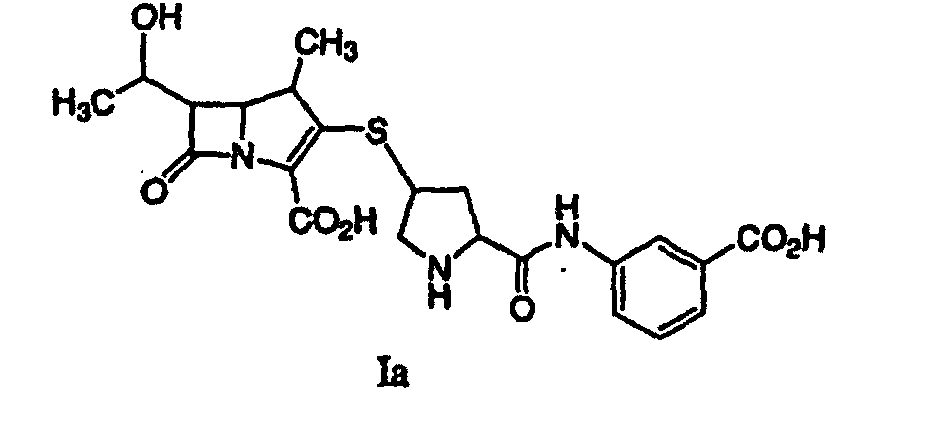
42. A process for synthesizing a compound represented by formula I:
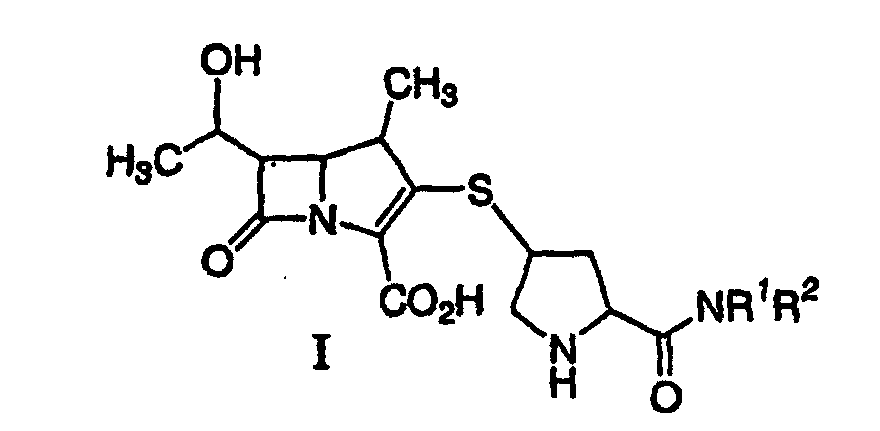
or a pharmaceutically acceptable salt thereof, containing pharmaceutically acceptable levels of a metal derived from a metal catalyst, wherein R1 and R2 independently are H, C1-10 alkyl, aryl or heteroaryl, said alkyl, aryl or heteroaryl being substituted or unsubstituted, comprising deprotecting a compound of formula II:

by hydrogenolysis in the presence of a prereduced metal catalyst and base to give a compound of formula I, followed by purifying and isolating the compound of formula I, wherein P is a carboxyl protecting group, P* is H, H2+, or a protecting group which can be removed by hydrogenolysis, and R1 and R2 are as described above.
or a pharmaceutically acceptable salt thereof, containing pharmaceutically acceptable levels of a metal derived from a metal catalyst, wherein R1 and R2 independently are H, C1-10 alkyl, aryl or heteroaryl, said alkyl, aryl or heteroaryl being substituted or unsubstituted, comprising deprotecting a compound of formula II:
by hydrogenolysis in the presence of a prereduced metal catalyst and base to give a compound of formula I, followed by purifying and isolating the compound of formula I, wherein P is a carboxyl protecting group, P* is H, H2+, or a protecting group which can be removed by hydrogenolysis, and R1 and R2 are as described above.
43. A process according to claim 42 for synthesizing a compound represented by formula
Ia:

or a pharmaceutically acceptable salt thereof, containing pharmaceutically acceptable levels of a metal derived from a metal catalyst, comprising deprotecting a compound of formula IIa:

by hydrogenolysis in the presence of a prereduced metal catalyst and base to give a compound of formula Ia, followed by purifying and isolating the compound of formula Ia, wherein P is a carboxyl protecting group, P* is H, H2+, or a protecting group which can be removed by hydrogenolysis.
or a pharmaceutically acceptable salt thereof, containing pharmaceutically acceptable levels of a metal derived from a metal catalyst, comprising deprotecting a compound of formula IIa:
by hydrogenolysis in the presence of a prereduced metal catalyst and base to give a compound of formula Ia, followed by purifying and isolating the compound of formula Ia, wherein P is a carboxyl protecting group, P* is H, H2+, or a protecting group which can be removed by hydrogenolysis.
1. Ein Verfahren zur Synthese einer durch Formel

dargestellten Verbindung oder eines pharmazeutisch annehmbaren Salzes davon, wobei R1 und R2 unabhängig H, C1-10-Alkyl, Aryl oder Heteroaryl sind, wobei das Alkyl, Aryl oder Heteroaryl substituiert oder unsubstituiert ist, umfassend die Entfernung der Schutzgruppe(n) von einer Verbindung der Formel II:

durch Hydrogenolyse in Gegenwart eines vorreduzierten Metallkatalysators und einer Base, um die Verbindung der Formel I zu ergeben, gefolgt von der Reinigung und Isolierung der Verbindung der Formel I, wobei P eine Carboxylschutzgruppe ist, P* H, H2+ oder eine Schutzgruppe ist, die durch Hydrogenolyse entfernt werden kann, und R1 und R2 wie oben beschrieben sind.
dargestellten Verbindung oder eines pharmazeutisch annehmbaren Salzes davon, wobei R1 und R2 unabhängig H, C1-10-Alkyl, Aryl oder Heteroaryl sind, wobei das Alkyl, Aryl oder Heteroaryl substituiert oder unsubstituiert ist, umfassend die Entfernung der Schutzgruppe(n) von einer Verbindung der Formel II:
durch Hydrogenolyse in Gegenwart eines vorreduzierten Metallkatalysators und einer Base, um die Verbindung der Formel I zu ergeben, gefolgt von der Reinigung und Isolierung der Verbindung der Formel I, wobei P eine Carboxylschutzgruppe ist, P* H, H2+ oder eine Schutzgruppe ist, die durch Hydrogenolyse entfernt werden kann, und R1 und R2 wie oben beschrieben sind.
2. Ein Verfahren gemäß Anspruch 1, wobei die Schutzgruppe Carbobenzyloxy oder p-Nitrobenzylcarbamoyl
(PNZ) ist.
3. Ein Verfahren gemäß Anspruch 1, wobei einer der Reste R1 oder R2 Wasserstoff ist und der andere ein mit CO2H substituiertes Aryl ist.
4. Ein Verfahren gemäß Anspruch 1, wobei der vorreduzierte Metallkatalysator ein Palladium-,
Platin- oder Rhodiumkatalysator ist.
5. Ein Verfahren gemäß Anspruch 4, wobei der Metallkatalysator ein Salz oder Metallpulver
ist oder auf festen Trägern getragen wird, ausgewählt aus der Gruppe, bestehend aus
Aluminiumoxid, Siliciumdioxid, Calciumcarbonat, Bariumcarbonat, Bariumsulfat, Strontiumcarbonat,
Polymeren oder Kohle.
6. Ein Verfahren gemäß Anspruch 5, wobei der Metallkatalysator vorreduziertes Palladium
auf Kohle ist.
7. Ein Verfahren gemäß Anspruch 1, wobei die Base Hydrogencarbonat oder vermischtes Hydroxid
und Kohlendioxid, um Hydrogencarbonat zu bilden, ist.
8. Ein Verfahren gemäß Anspruch 6, das ferner die Reinigung der Verbindung durch Anwendung
von Chromatographie mit hydrophobem Harz umfaßt.
9. Ein Verfahren gemäß Anspruch 8, das ferner das Konzentrieren der Verbindung in Lösung
unter Verwendung einer Nanofiltrationsmembran umfaßt.
10. Ein Verfahren gemäß Anspruch 9, das ferner die Kristallisation der Verbindung umfaßt.
11. Ein Verfahren gemäß Anspruch 1, wobei der Reinigungsschritt aus der Behandlung mit
Aktivkohle besteht.
12. Ein Verfahren gemäß Anspruch 6, das ferner die Extraktion einer Lösung, welche eine
Verbindung der Formel I oder 3:

oder ein pharmazeutisch annehmbares Salz davon enthält, wobei jedes X+ eine ladungsausgleichende Gruppe ist und R1 und R2 wie oben beschrieben sind, mit einem C4-10-Alkohol, die Reinigung und die Isolierung der Verbindung der Formel I aus der resultierenden wäßrigen Phase umfaßt.
oder ein pharmazeutisch annehmbares Salz davon enthält, wobei jedes X+ eine ladungsausgleichende Gruppe ist und R1 und R2 wie oben beschrieben sind, mit einem C4-10-Alkohol, die Reinigung und die Isolierung der Verbindung der Formel I aus der resultierenden wäßrigen Phase umfaßt.
13. Ein Verfahren gemäß Anspruch 12, wobei die Extraktion mit einem Alkohol in Gegenwart
eines Ionenpaar-Reagenzes durchgeführt wird, während der pH-Wert der wäßrigen Phase
zwischen neutral und leicht basisch gehalten wird.
14. Ein Verfahren gemäß Anspruch 13, wobei die Extraktion unter Verwendung eines Mehrstufen-Extraktors
durchgeführt wird.
15. Ein Verfahren gemäß Anspruch 14, wobei die Extraktion durch Verwendung eines Mehrstufen-Gegenstromzentrifugalextraktors
durchgeführt wird.
16. Ein Verfahren gemäß Anspruch 13, wobei der Alkohol Isoamylalkohol, tert.-Amylalkohol,
1-Butanol, 2-Butanol, 1-Octanol, 1-Hexanol, 1-Heptanol, Cyclohexanol, 1-Pentanol,
Cyclopentanol, 2-Pentanol, 2-Methyl-1-pentanol, 2-Ethyl-1-butanol, 4-Methyl-2-pentanol,
2,6-Dimethyl-4-heptanol oder 2-Methylcyclohexanol ist.
17. Ein Verfahren gemäß Anspruch 16, wobei der Alkohol Isoamylalkohol oder 1-Butanol ist.
18. Ein Verfahren gemäß Anspruch 13, wobei das Ionenpaar-Reagenz C6-24-Carbonsäuren, Phosphorsäuren, Phosphinsäuren, Sulfonsäuren oder deren Salze enthält.
19. Ein Verfahren gemäß Anspruch 17, wobei das Ionenpaar-Reagenz ein Natriumsalz von Diphenylphosphorsäure,
Stearinsäure oder Dodecylbenzolsulfonsäure ist.
20. Ein Verfahren gemäß Anspruch 12, wobei die extrahierte Lösung eine Verbindung der
Formel I enthält.
21. Ein Verfahren gemäß Anspruch 12, wobei die extrahierte Lösung eine Verbindung der
Formel 3 enthält.
22. Ein Verfahren zur Synthese einer durch Formel Ia

dargestellten Verbindung oder eines pharmazeutisch annehmbaren Salzes davon wird offenbart, umfassend die Entfernung der Schutzgruppe(n) von einer Verbindung der Formel IIa:

durch Hydrogenolyse in Gegenwart eines vorreduzierten Metallkatalysators und einer Base, um eine Verbindung der Formel Ia zu ergeben, gefolgt von der Reinigung und Isolierung der Verbindung der Formel Ia, wobei P eine Carboxylschutzgruppe ist, P* H, H2+ oder eine Schutzgruppe ist, die durch Hydrogenolyse entfernt werden kann, und X+ eine ladungsausgleichende Gruppe ist.
dargestellten Verbindung oder eines pharmazeutisch annehmbaren Salzes davon wird offenbart, umfassend die Entfernung der Schutzgruppe(n) von einer Verbindung der Formel IIa:
durch Hydrogenolyse in Gegenwart eines vorreduzierten Metallkatalysators und einer Base, um eine Verbindung der Formel Ia zu ergeben, gefolgt von der Reinigung und Isolierung der Verbindung der Formel Ia, wobei P eine Carboxylschutzgruppe ist, P* H, H2+ oder eine Schutzgruppe ist, die durch Hydrogenolyse entfernt werden kann, und X+ eine ladungsausgleichende Gruppe ist.
23. Ein Verfahren gemäß Anspruch 22, wobei die P*-Schutzgruppe Carbobenzyloxy oder p-Nitrobenzylcarbamoyl
(PNZ) ist.
24. Ein Verfahren gemäß Anspruch 22, wobei der vorreduzierte Metallkatalysator ein Palladium-,
Platin- oder Rhodiumkatalysator ist.
25. Ein Verfahren gemäß Anspruch 24, wobei der Metallkatalysator ein Salz oder Metallpulver
ist oder auf festen Trägern getragen wird, ausgewählt aus der Gruppe, bestehend aus
Aluminiumoxid, Siliciumdioxid, Calciumcarbonat, Bariumcarbonat, Bariumsulfat, Strontiumcarbonat,
Polymeren oder Kohle.
26. Ein Verfahren gemäß Anspruch 25, wobei der Metallkatalysator vorreduziertes Palladium
auf Kohle ist.
27. Ein Verfahren gemäß Anspruch 22, wobei die Base Hydrogencarbonat oder vermischtes
Hydroxid und Kohlendioxid, um Hydrogencarbonat zu bilden, ist.
28. Ein Verfahren gemäß Anspruch 22, wobei der Reinigungsschritt aus der Behandlung mit
Aktivkohle besteht.
29. Ein Verfahren gemäß Anspruch 25, das ferner die Reinigung der Verbindung durch Anwendung
von Chromatographie mit hydrophobem Harz umfaßt.
30. Ein Verfahren gemäß Anspruch 28, das ferner das Einengen einer Lösung der Verbindung
unter Verwendung einer Nanofiltrationsmembran umfaßt.
31. Ein Verfahren gemäß Anspruch 29, das ferner die Kristallisation der Verbindung umfaßt.
32. Ein Verfahren gemäß Anspruch 26, das ferner die Reinigung der Verbindung durch Extraktion
einer Lösung, welche eine Verbindung der Formel Ia oder 3a:

oder ein pharmazeutisch annehmbares Salz davon enthält, wobei jedes X+ eine ladungsausgleichende Gruppe ist, mit einem C4-10-Alkohol, die Kristallisation und das Sammeln einer Verbindung der Formel Ia' aus der resultierenden wäßrigen Phase umfaßt.
oder ein pharmazeutisch annehmbares Salz davon enthält, wobei jedes X+ eine ladungsausgleichende Gruppe ist, mit einem C4-10-Alkohol, die Kristallisation und das Sammeln einer Verbindung der Formel Ia' aus der resultierenden wäßrigen Phase umfaßt.
33. Ein Verfahren gemäß Anspruch 32, wobei die Extraktion mit einem Alkohol in Gegenwart
eines Ionenpaar-Reagenzes durchgeführt wird, während der pH-Wert der wäßrigen Phase
zwischen neutral und leicht basisch gehalten wird.
34. Ein Verfahren gemäß Anspruch 33, wobei die Extraktion unter Verwendung eines Mehrstufen-Extraktors
durchgeführt wird.
35. Ein Verfahren gemäß Anspruch 34, wobei die Extraktion durch Verwendung eines Mehrstufen-Gegenstromzentrifugalextraktors
durchgeführt wird.
36. Ein Verfahren gemäß Anspruch 33, wobei der Alkohol Isoamylalkohol, tert.-Amylalkohol,
1-Butanol, 2-Butanol, 1-Octanol, 1-Hexanol, 1-Heptanol, Cyclohexanol, 1-Pentanol,
Cyclopentanol, 2-Pentanol, 2-Methyl-1-pentanol, 2-Ethyl-1-butanol, 4-Methyl-2-pentanol,
2,6-Dimethyl-4-heptanol oder 2-Methylcyclohexanol ist.
37. Ein Verfahren gemäß Anspruch 36, wobei der Alkohol Isoamylalkohol oder 1-Butanol ist.
38. Ein Verfahren gemäß Anspruch 33, wobei das Ionenpaar-Reagenz C6-24-Carbonsäuren, Phosphorsäuren, Phosphinsäuren, Sulfonsäuren oder deren Salze enthält.
39. Ein Verfahren gemäß Anspruch 38, wobei das Ionenpaar-Reagenz ein Natriumsalz von Diphenylphosphorsäure,
Stearinsäure oder Dodecylbenzolsulfonsäure ist.
40. Ein Verfahren gemäß Anspruch 32, wobei die extrahierte Lösung eine Verbindung der
Formel 3a enthält:

41. Ein Verfahren gemäß Anspruch 32, wobei die extrahierte Lösung eine Verbindung der
Formel Ia enthält:

42. Ein Verfahren zur Synthese einer durch Formel I:
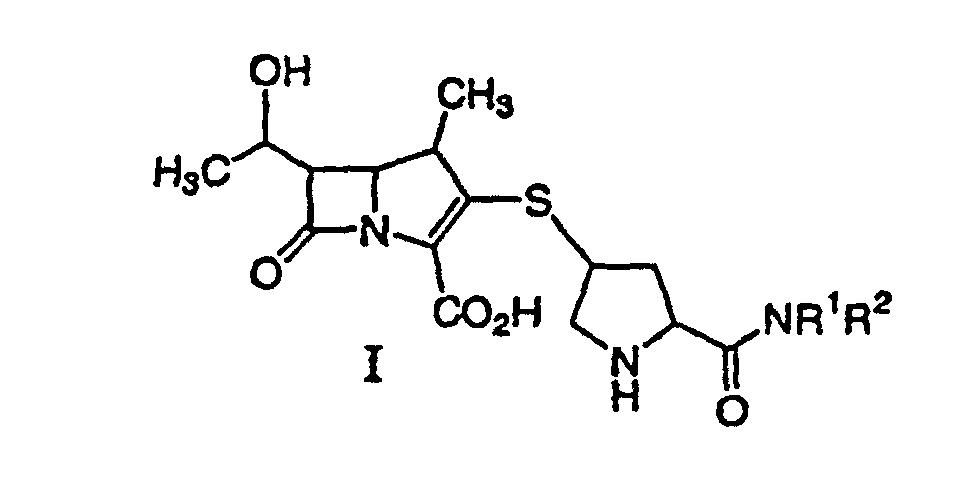
dargestellten Verbindung oder eines pharmazeutisch annehmbaren Salzes davon, das pharmazeutisch annehmbare Gehalte eines von einem Metallkatalysator stammenden Metalls enthält, wobei R1 und R2 unabhängig H, C1-10-Alkyl, Aryl oder Heteroaryl sind, wobei Alkyl, Aryl oder Heteroaryl substituiert oder unsubstituiert sind, umfassend die Entfernung der Schutzgruppe(n) von einer Verbindung der Formel II:

durch Hydrogenolyse in Gegenwart eines vorreduzierten Metallkatalysators und einer Base, um eine Verbindung der Formel I zu ergeben, gefolgt von der Reinigung und Isolierung der Verbindung der Formel I, wobei P eine Carboxylschutzgruppe ist, P* H, H2+ oder eine Schutzgruppe ist, die durch Hydrogenolyse entfernt werden kann, und R1 und R2 wie oben beschrieben sind.
dargestellten Verbindung oder eines pharmazeutisch annehmbaren Salzes davon, das pharmazeutisch annehmbare Gehalte eines von einem Metallkatalysator stammenden Metalls enthält, wobei R1 und R2 unabhängig H, C1-10-Alkyl, Aryl oder Heteroaryl sind, wobei Alkyl, Aryl oder Heteroaryl substituiert oder unsubstituiert sind, umfassend die Entfernung der Schutzgruppe(n) von einer Verbindung der Formel II:
durch Hydrogenolyse in Gegenwart eines vorreduzierten Metallkatalysators und einer Base, um eine Verbindung der Formel I zu ergeben, gefolgt von der Reinigung und Isolierung der Verbindung der Formel I, wobei P eine Carboxylschutzgruppe ist, P* H, H2+ oder eine Schutzgruppe ist, die durch Hydrogenolyse entfernt werden kann, und R1 und R2 wie oben beschrieben sind.
43. Ein Verfahren gemäß Anspruch 42 zur Synthese einer durch Formel Ia:
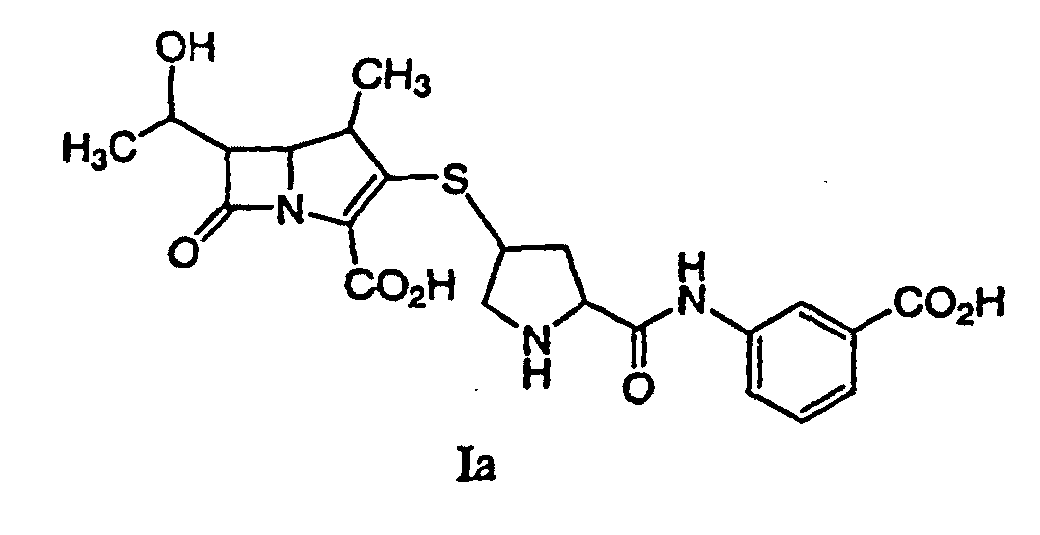
dargestellten Verbindung oder eines pharmazeutisch annehmbaren Salzes davon, das pharmazeutisch annehmbare Gehalte eines von einem Metallkatalysator stammenden Metalls enthält, umfassend die Entfernung der Schutzgruppe(n) von einer Verbindung der Formel IIa:
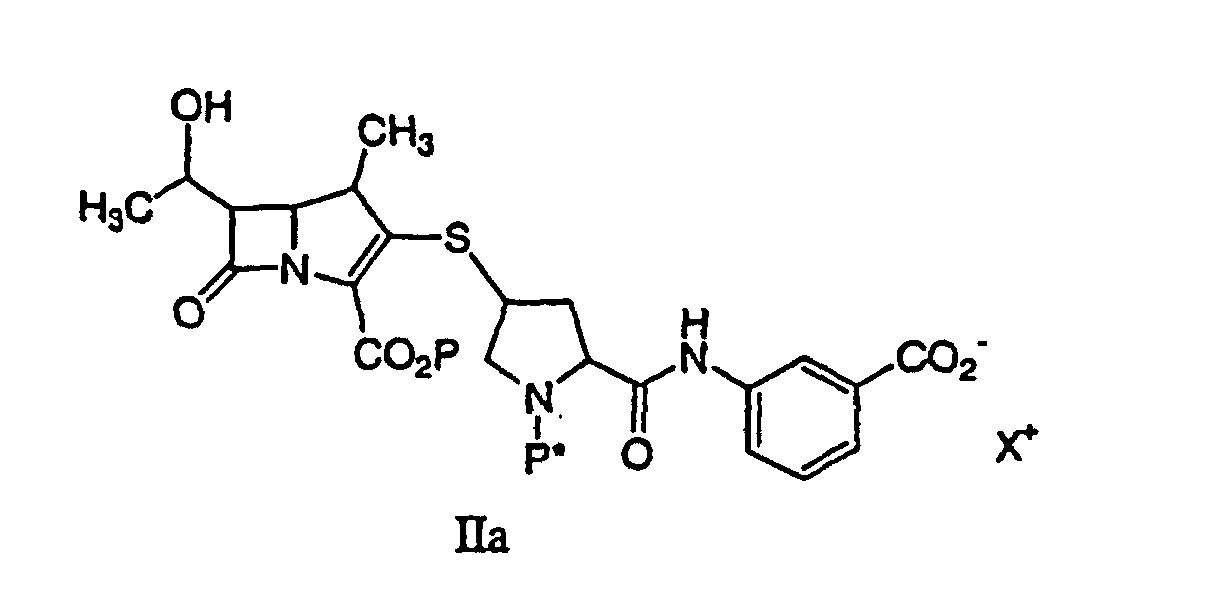
durch Hydrogenolyse in Gegenwart eines vorreduzierten Metallkatalysators und einer Base, um eine Verbindung der Formel Ia zu ergeben, gefolgt von der Reinigung und Isolierung der Verbindung der Formel Ia, wobei P eine Carboxylschutzgruppe ist, P* H, H2+ oder eine Schutzgruppe ist, die durch Hydrogenolyse entfernt werden kann.
dargestellten Verbindung oder eines pharmazeutisch annehmbaren Salzes davon, das pharmazeutisch annehmbare Gehalte eines von einem Metallkatalysator stammenden Metalls enthält, umfassend die Entfernung der Schutzgruppe(n) von einer Verbindung der Formel IIa:
durch Hydrogenolyse in Gegenwart eines vorreduzierten Metallkatalysators und einer Base, um eine Verbindung der Formel Ia zu ergeben, gefolgt von der Reinigung und Isolierung der Verbindung der Formel Ia, wobei P eine Carboxylschutzgruppe ist, P* H, H2+ oder eine Schutzgruppe ist, die durch Hydrogenolyse entfernt werden kann.
1. Procédé pour synthétiser un composé représenté par la formule I :
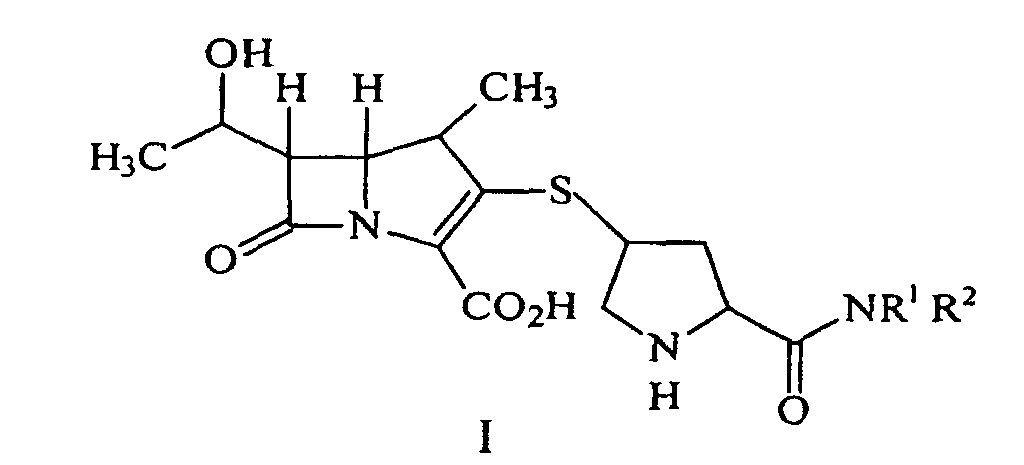
ou un de ses sels pharmaceutiquement acceptable, dans laquelle R1 et R2 sont de façon indépendante H, un alkyle en C1-C10, un aryle ou un hétéroaryle, ledit alkyle, aryle ou hétéroaryle étant substitué ou non substitué, comprenant la déprotection d'un composé de formule II :

par hydrogénolyse en présence d'un catalyseur métallique pré-réduit et d'une base pour donner le composé de formule I, suivi par la purification et l'isolement du composé de formule I, dans laquelle P est un groupe protecteur carboxyle; P* est H, H2+, ou un groupe protecteur qui peut être éliminé par hydrogénolyse, et R1 et R2 sont tels que décrits ci-dessus.
ou un de ses sels pharmaceutiquement acceptable, dans laquelle R1 et R2 sont de façon indépendante H, un alkyle en C1-C10, un aryle ou un hétéroaryle, ledit alkyle, aryle ou hétéroaryle étant substitué ou non substitué, comprenant la déprotection d'un composé de formule II :
par hydrogénolyse en présence d'un catalyseur métallique pré-réduit et d'une base pour donner le composé de formule I, suivi par la purification et l'isolement du composé de formule I, dans laquelle P est un groupe protecteur carboxyle; P* est H, H2+, ou un groupe protecteur qui peut être éliminé par hydrogénolyse, et R1 et R2 sont tels que décrits ci-dessus.
2. Procédé selon la revendication 1, caractérisé en ce que le groupe protecteur est le carbobenzyloxy ou le p-nitrobenzyle carbamoyle (PNZ).
3. Procédé selon la revendication 1, caractérisé en ce que l'un de R1 ou R2 est un hydrogène et l'autre un aryle substitué par CO2H.
4. Procédé selon la revendication 1, caractérisé en ce que le catalyseur métallique pré-réduit est un catalyseur de palladium, de platine ou
de rhodium.
5. Procédé selon la revendication 4, caractérisé en ce que le catalyseur métallique est un sel ou une poudre métallique ou est supporté sur
des substrats solides choisis dans le groupe qui comprend alumine, silice, carbonate
de calcium, carbonate de baryum, sulfate de baryum, carbonate de strontium, polymères,
ou carbone.
6. Procédé selon la revendication 5, caractérisé en ce que le catalyseur métallique est du palladium pré-réduit sur du carbone.
7. Procédé selon la revendication 1, caractérisé en ce que la base est du bicarbonate ou de l'hydroxyde mélangé à du dioxyde de carbone pour
faire du bicarbonate.
8. Procédé selon la revendication 6, comprenant en plus la purification du composé en
utilisant la chromatographie sur résine hydrophobe.
9. Procédé selon la revendication 8, comprenant en plus la concentration du composé en
solution en utilisant une membrane pour nanofiltration.
10. Procédé selon la revendication 9, comprenant en plus la cristallisation du composé.
11. Procédé selon la revendication 1, caractérisé en ce que la purification consiste en un traitement avec du noir de carbone.
12. Procédé selon la revendication 6, comprenant en plus l'extraction d'une solution contenant
un composé de formule I ou 3 :

ou un de leurs sels pharmaceutiquement acceptable, où chaque X+ est un groupe pour équilibrer la charge et R1 et R2 sont tels que décrits ci-dessus, par un alcool en C4-10, purification et isolement du composé de formule I à partir de la phase aqueuse obtenue.
ou un de leurs sels pharmaceutiquement acceptable, où chaque X+ est un groupe pour équilibrer la charge et R1 et R2 sont tels que décrits ci-dessus, par un alcool en C4-10, purification et isolement du composé de formule I à partir de la phase aqueuse obtenue.
13. Procédé selon la revendication 12, caractérisé en ce que l'extraction est effectuée avec un alcool en présence d'un réactif pour appariement
d'ions, tout en maintenant le pH de la phase entre neutre et légèrement basique.
14. Procédé selon la revendication 13, caractérisé en ce que l'extraction est effectuée en utilisant un extracteur à étages multiples.
15. Procédé selon la revendication 14, caractérisé en ce que l'extraction est effectuée en utilisant un extracteur centrifuge à contre courant
à étages multiples.
16. Procédé en accord avec la revendication 13, caractérisé en ce que l'alcool est l'alcool iso-amylique, l'alcool tert-amylique, le 1-butanol, le 2-butanol,
le 1-octanol, le 1-hexanol, le 1-heptanol, le cyclohexanol, le 1-pentanol, le cyclopentanol,
le 2-pentanol, le 2-méthyl-1-pentanol, le 2-éthyl-1-butanol, le 4-méthyl-2-pentanol,
le 2,6-diméthyl-4-heptanol ou le 2-méthylcyclohexanol.
17. Procédé en accord avec la revendication 16, caractérisé en ce que l'alcool est l'alcool iso-amylique ou le 1-butanol.
18. Procédé en accord avec la revendication 13, caractérisé en ce que le réactif pour appariement d'ions comprend des acides carboxyliques en C6-24, des acides phosphoriques, des acides phosphiniques, des acides sulfoniques ou leurs
sels.
19. Procédé en accord avec la revendication 17, caractérisé en ce que le réactif pour appariement d'ions est un sel de sodium de l'acide diphénylphosphorique,
de l'acide stéarique ou de l'acide dodécyl benzènesulfonique.
20. Procédé selon la revendication 12, caractérisé en ce que la solution extraite contient un composé de formule I.
21. Procédé selon la revendication 12, caractérisé en ce que la solution extraite contient un composé de formule 3.
22. Procédé pour synthétiser un composé représenté par la formule Ia :
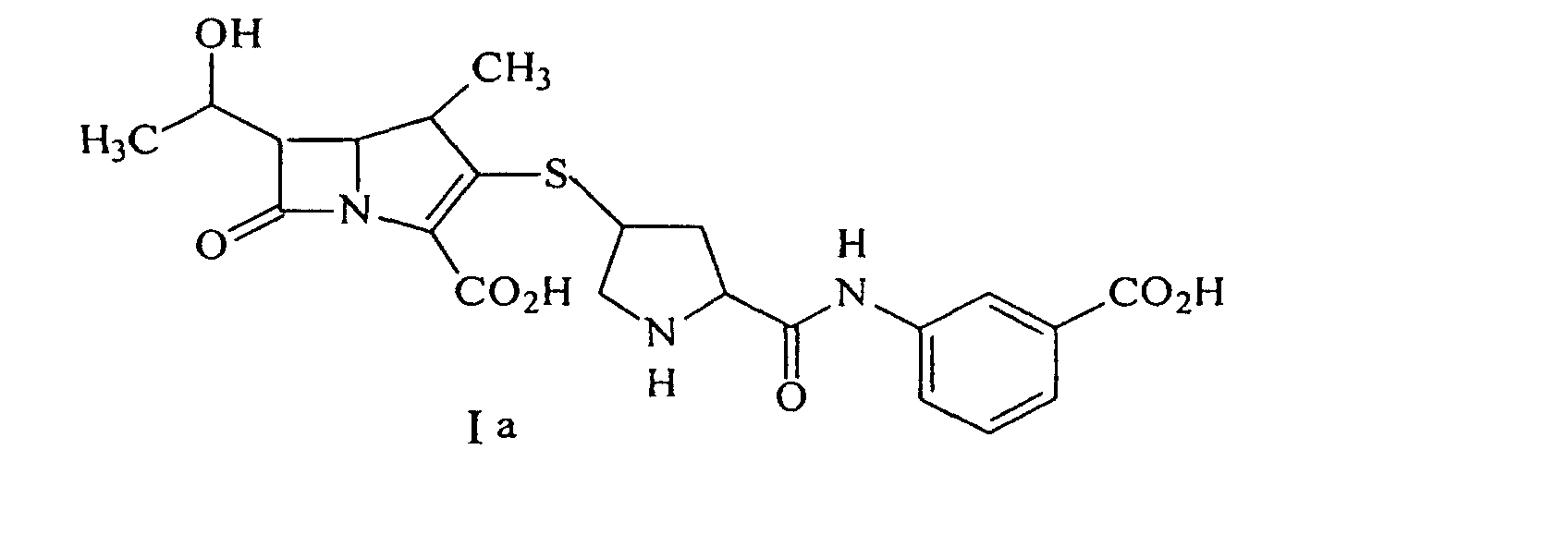
ou un de ses sels pharmaceutiquement acceptable, divulgué comprenant la déprotection d'un composé de formule IIa :

par hydrogénolyse en présence d'un catalyseur métallique pré-réduit et d'une base pour donner le composé de formule Ia, suivi par la purification et l'isolement du composé de formule Ia, dans laquelle P est un groupe protecteur carboxyle; P* est H, H2+, ou un groupe protecteur qui peut être éliminé par hydrogénolyse, et X+ est un groupe pour équilibrer la charge.
ou un de ses sels pharmaceutiquement acceptable, divulgué comprenant la déprotection d'un composé de formule IIa :
par hydrogénolyse en présence d'un catalyseur métallique pré-réduit et d'une base pour donner le composé de formule Ia, suivi par la purification et l'isolement du composé de formule Ia, dans laquelle P est un groupe protecteur carboxyle; P* est H, H2+, ou un groupe protecteur qui peut être éliminé par hydrogénolyse, et X+ est un groupe pour équilibrer la charge.
23. Procédé en accord avec la revendication 22, caractérisé en ce que le groupe protecteur P* est le carbobenzyloxy ou le p-nitrobenzyle carbamoyle (PNZ).
24. Procédé selon la revendication 22, caractérisé en ce que le catalyseur métallique pré-réduit est un catalyseur de palladium, de platine ou
de rhodium.
25. Procédé selon la revendication 24, caractérisé en ce que le catalyseur métallique est un sel ou une poudre métallique ou est supporté sur
des substrats solides choisis dans le groupe qui comprend alumine, silice, carbonate
de calcium, carbonate de baryum, sulfate de baryum, carbonate de strontium, polymères,
ou carbone.
26. Procédé selon la revendication 25, caractérisé en ce que le catalyseur métallique est du palladium pré-réduit sur du carbone.
27. Procédé selon la revendication 22, caractérisé en ce que la base est du bicarbonate ou de l'hydroxyde mélangé à du dioxyde de carbone pour
faire du bicarbonate.
28. Procédé selon la revendication 22, caractérisé en ce que la purification consiste en un traitement avec du charbon actif.
29. Procédé selon la revendication 25, comprenant en plus la purification du composé en
utilisant la chromatographie sur résine hydrophobe.
30. Procédé selon la revendication 28, comprenant en plus la concentration du composé
en solution en utilisant une membrane pour nanofiltration
31. Procédé selon la revendication 29, comprenant en plus la cristallisation du composé.
32. Procédé selon la revendication 26, comprenant en plus la purification du composé par
l'extraction d'une solution contenant un composé de formule Ia ou 3a
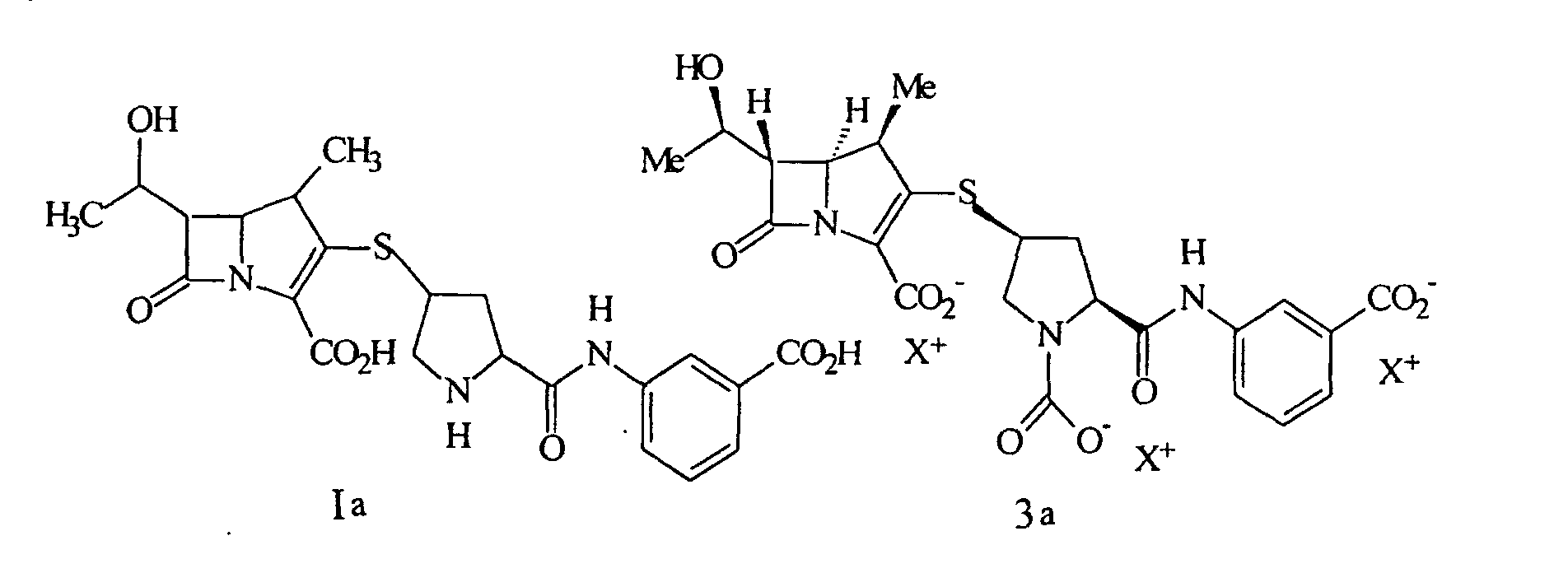
ou un de leurs sels pharmaceutiquement acceptable, où chaque X+ est un groupe pour équilibrer la charge, par un alcool en C4-10, cristallisation et recueil du composé de formule Ia' à partir de la phase aqueuse obtenue.
ou un de leurs sels pharmaceutiquement acceptable, où chaque X+ est un groupe pour équilibrer la charge, par un alcool en C4-10, cristallisation et recueil du composé de formule Ia' à partir de la phase aqueuse obtenue.
33. Procédé selon la revendication 32, caractérisé en ce que l'extraction est effectuée avec un alcool en présence d'un réactif pour appariement
d'ions, tout en maintenant le pH de la phase aqueuse entre neutre et légèrement basique.
34. Procédé selon la revendication 33, caractérisé en ce que l'extraction est effectuée en utilisant un extracteur à étages multiples.
35. Procédé selon la revendication 34, caractérisé en ce que l'extraction est effectuée en utilisant un extracteur centrifuge à contre courant
à étages multiples.
36. Procédé selon la revendication 33, caractérisé en ce que l'alcool est l'alcool iso-amylique, l'alcool tert-amylique, le 1-butanol, le 2-butanol,
le 1-octanol, le 1-hexanol, le 1-heptanol, le cyclohexanol, le 1-pentanol, le cyclopentanol,
le 2-pentanol, le 2-méthyl-1-pentanol, le 2-éthyl-1-butanol, le 4-méthyl-2-pentanol,
le 2,6-diméthyl-4-heptanol ou le 2-méthylcyclohexanol.
37. Procédé selon la revendication 36, caractérisé en ce que l'alcool est l'alcool iso-amylique ou le 1-butanol.
38. Procédé selon la revendication 33, caractérisé en ce que le réactif pour appariement d'ions comprend des acides carboxyliques en C6-24, des acides phosphoriques, des acides phosphiniques, des acides sulfoniques ou leurs
sels.
39. Procédé en accord avec la revendication 38, caractérisé en ce que le réactif pour appariement d'ions est un sel de sodium de l'acide diphénylphosphorique,
de l'acide stéarique ou de l'acide dodécyl benzènesulfonique.
40. Procédé selon la revendication 32, caractérisé en ce que la solution extraite contient un composé de formule 3a :

41. Procédé selon la revendication 32, caractérisé en ce que la solution extraite contient un composé de formule Ia :

42. Procédé pour synthétiser un composé représenté par la formule I :
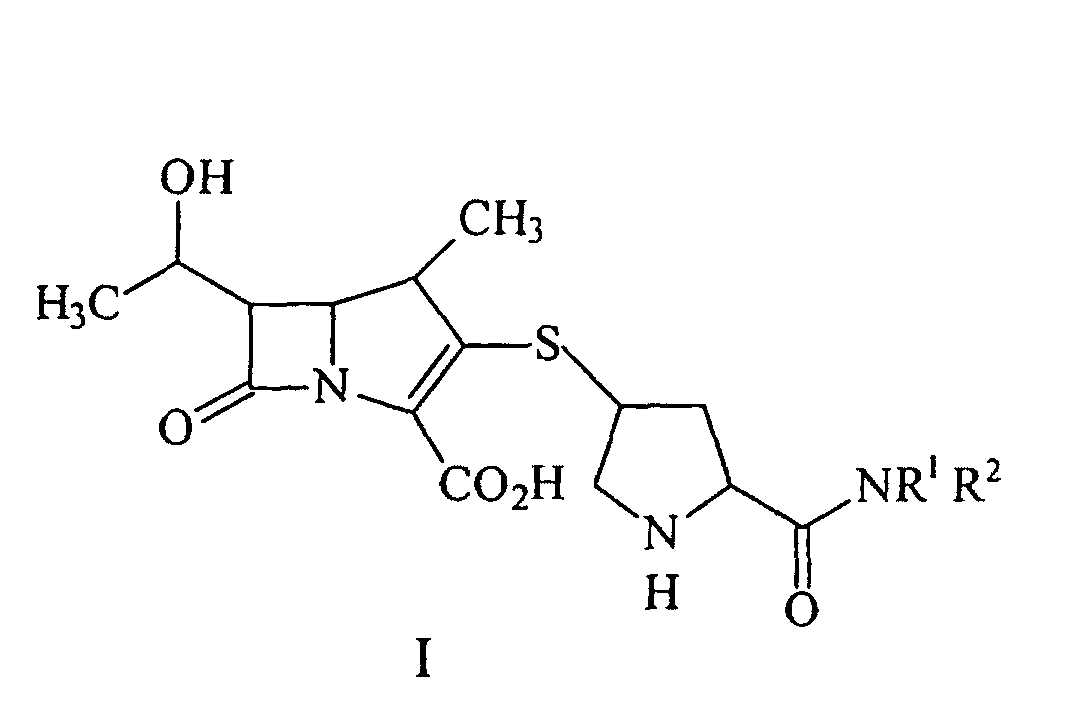
ou un de ses sels pharmaceutiquement acceptable, contenant à des niveaux pharmaceutiquement acceptables un métal dérivé d'un catalyseur métallique, dans laquelle R1 et R2 sont de façon indépendante H, un alkyle en C1-C10, un aryle ou un hétéroaryle, ledit alkyle, aryle ou hétéroaryle étant substitué ou non substitué, comprenant la déprotection d'un composé de formule II :

par hydrogénolyse en présence d'un catalyseur métallique pré-réduit et d'une base pour donner le composé de formule I, suivi par la purification et l'isolement du composé de formule I, dans laquelle P est un groupe protecteur carboxyle ; P* est H, H2+, ou un groupe protecteur qui peut être éliminé par hydrogénolyse, et R1 et R2 sont tels que décrits ci-dessus.
ou un de ses sels pharmaceutiquement acceptable, contenant à des niveaux pharmaceutiquement acceptables un métal dérivé d'un catalyseur métallique, dans laquelle R1 et R2 sont de façon indépendante H, un alkyle en C1-C10, un aryle ou un hétéroaryle, ledit alkyle, aryle ou hétéroaryle étant substitué ou non substitué, comprenant la déprotection d'un composé de formule II :
par hydrogénolyse en présence d'un catalyseur métallique pré-réduit et d'une base pour donner le composé de formule I, suivi par la purification et l'isolement du composé de formule I, dans laquelle P est un groupe protecteur carboxyle ; P* est H, H2+, ou un groupe protecteur qui peut être éliminé par hydrogénolyse, et R1 et R2 sont tels que décrits ci-dessus.
43. Procédé selon la revendication 42, pour synthétiser un composé représenté par la formule
Ia :

ou un de ses sels pharmaceutiquement acceptable, contenant des niveaux pharmaceutiquement acceptables d'un métal dérivé d'un catalyseur métallique, comprenant la déprotection d'un composé de formule IIa :
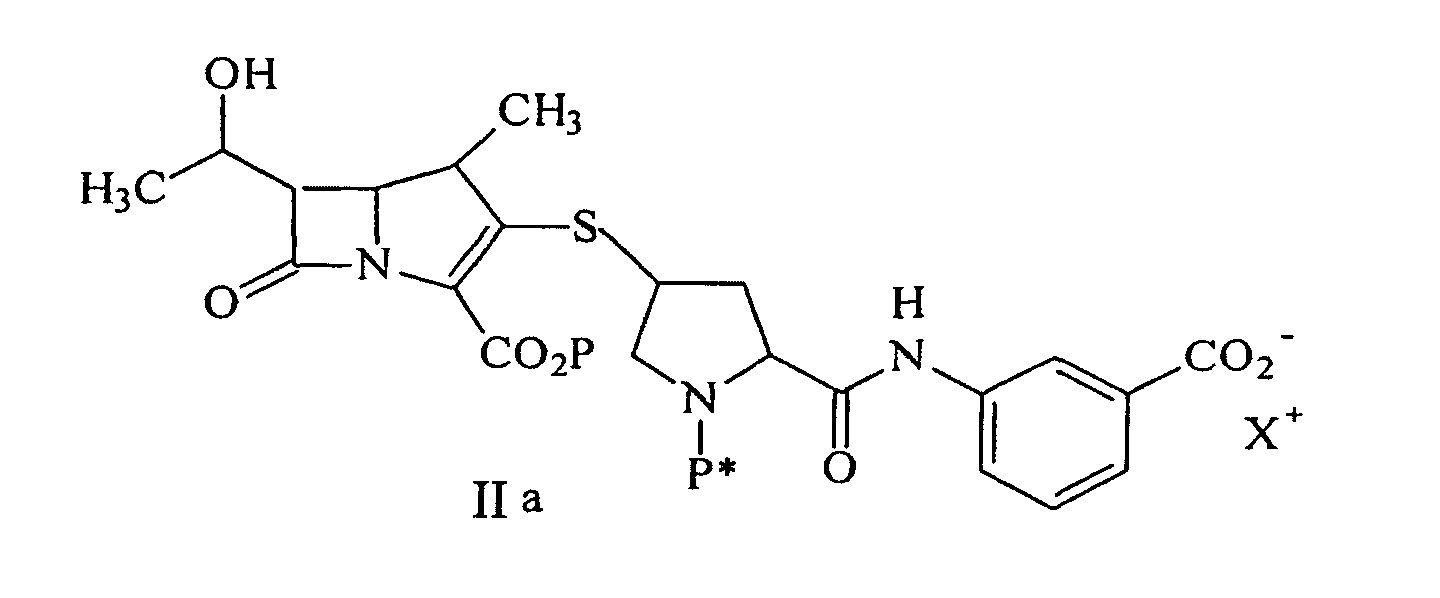
par hydrogénolyse en présence d'un catalyseur métallique pré-réduit et d'une base pour donner le composé de formule la, suivi par la purification et l'isolement du composé de formule Ia, dans laquelle P est un groupe protecteur carboxyle ; P* est H, H2+, ou un groupe protecteur qui peut être éliminé par hydrogénolyse.
ou un de ses sels pharmaceutiquement acceptable, contenant des niveaux pharmaceutiquement acceptables d'un métal dérivé d'un catalyseur métallique, comprenant la déprotection d'un composé de formule IIa :
par hydrogénolyse en présence d'un catalyseur métallique pré-réduit et d'une base pour donner le composé de formule la, suivi par la purification et l'isolement du composé de formule Ia, dans laquelle P est un groupe protecteur carboxyle ; P* est H, H2+, ou un groupe protecteur qui peut être éliminé par hydrogénolyse.
